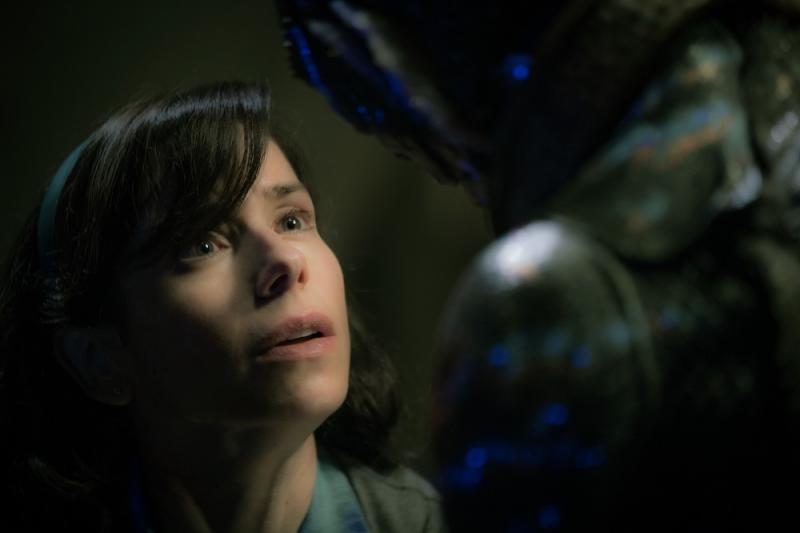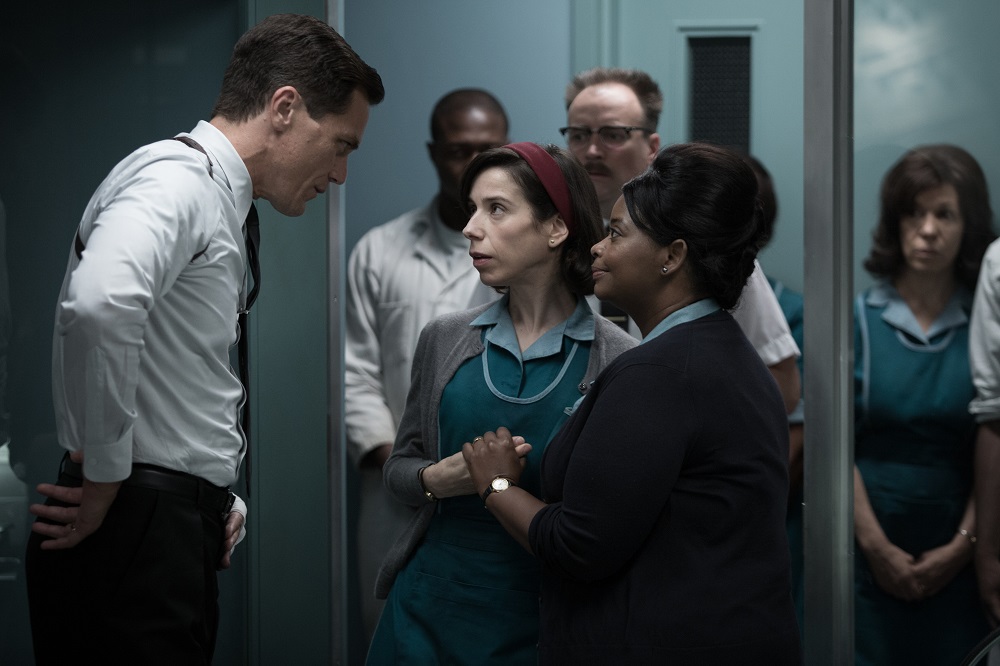The Shape of Water review - love in a Cold War climate | reviews, news & interviews
The Shape of Water review - love in a Cold War climate
The Shape of Water review - love in a Cold War climate
Guillermo del Toro's creature-feature fable is a fine romance

Guillermo del Toro has laid down markers as a wizard of the fantastical with such previous works as Pan’s Labyrinth and Crimson Peak (though we’ll skate nimbly around Pacific Rim), and now he has brought it all back home with The Shape of Water, as its 13 Academy Award nom
In outline, it’s a Cold War monster movie mashed together with an unearthly love story, alchemised by an infatuation with old Hollywood. Del Toro’s main human protagonist is Elisa Esposito (Sally Hawkins), who lives above the vintage Orpheum picture house in Baltimore and takes the bus every evening to the sinister Occam Aerospace Research Center, where she works as a cleaner. It’s paranoia-laden 1962 (the year of the Cuban missile crisis), and the Occam Center is a warren of cranky-looking gadgets, wires, tanks, dials and cables with which teams of boffins aim to concoct weaponry to combat the Russians. The latter now have spacecraft to go with their nuclear arsenal.
Elisa, who’s been left mute by a childhood accident, nonetheless enjoys a close relationship with her fellow-cleaner Zelda (Octavia Spencer), as well as with her next-door neighbour Giles (an eccentric but benign Richard Jenkins). He’s a veteran advertising illustrator now devastated to find his painstaking drawing style is obsolete and he’s being put out to grass. Zelda and Elisa are less than impressed with the arrival at the facility of Colonel Richard Strickland (a mean and macho Michael Shannon, pictured above with Hawkins and Spencer), a hard-assed military super-hawk right out of Dr Strangelove’s gallery of war-freaks. To the women’s disgust, Strickland likes to urinate with his hands on his hips and never washes his hands, a devastatingly effective clue to the nature of the man.
Zelda and Elisa are less than impressed with the arrival at the facility of Colonel Richard Strickland (a mean and macho Michael Shannon, pictured above with Hawkins and Spencer), a hard-assed military super-hawk right out of Dr Strangelove’s gallery of war-freaks. To the women’s disgust, Strickland likes to urinate with his hands on his hips and never washes his hands, a devastatingly effective clue to the nature of the man.
Strickland is in charge of a special project, involving a mysterious creature known as “the Asset”. Elisa first becomes aware of it after hearing bloodcurdling screams emanating from the tank in which he’s kept. She finds a way to sneak in to visit the mystery guest, who proves to be an exotic aqua-man from the Amazon (said to possess god-like powers). Played by the imposingly tall Doug Jones, the amphibian is a strangely sexy and athletic-looking beast, with big luminous eyes over which delicate eyelids flick laterally.
Strickland’s “research” on the creature is little more than cold-blooded sadism involving an electric cattle-prod, but Elisa finds a way to his heart with gifts of hard-boiled eggs, and they bond using a mix of her sign language and his intriguing underwater noises, to a soundtrack of Glenn Miller and Benny Goodman. The magic of the piece is the way she wordlessly blossoms, seemingly lit from within, as it becomes clear that her destiny is somehow entwined with the creature’s. She was, we learn, a child found beside water, and her mystical connection to good old H2O is evoked by her daily bouts of bath-time masturbation.
It’s a fable for the misfits and outcasts, as Elisa and her team try to figure out a way to free Amphibian-man from the cruel bondage of the military-industrial complex (and, by extension, the bigoted and illiberal society it has fostered). There’s excellent work, as there usually is, from Michael Stuhlbarg as Dr Robert Hoffstetler, a humane scientist struggling with divided loyalties, while Jones works wonders in locating the inner beauty in the beast. There’s darkness here, but del Toro lets us see the light.
Add comment
The future of Arts Journalism
You can stop theartsdesk.com closing!
We urgently need financing to survive. Our fundraising drive has thus far raised £49,000 but we need to reach £100,000 or we will be forced to close. Please contribute here: https://gofund.me/c3f6033d
And if you can forward this information to anyone who might assist, we’d be grateful.

Subscribe to theartsdesk.com
Thank you for continuing to read our work on theartsdesk.com. For unlimited access to every article in its entirety, including our archive of more than 15,000 pieces, we're asking for £5 per month or £40 per year. We feel it's a very good deal, and hope you do too.
To take a subscription now simply click here.
And if you're looking for that extra gift for a friend or family member, why not treat them to a theartsdesk.com gift subscription?
more Film
 Don't Let's Go to the Dogs Tonight review - vivid adaptation of a memoir about a Rhodesian childhood
Embeth Davidtz delivers an impressive directing debut and an exceptional child star
Don't Let's Go to the Dogs Tonight review - vivid adaptation of a memoir about a Rhodesian childhood
Embeth Davidtz delivers an impressive directing debut and an exceptional child star
 One Battle After Another review - Paul Thomas Anderson satirises America's culture wars
Leonardo DiCaprio, Teyana Taylor, and Sean Penn star in a rollercoasting political thriller
One Battle After Another review - Paul Thomas Anderson satirises America's culture wars
Leonardo DiCaprio, Teyana Taylor, and Sean Penn star in a rollercoasting political thriller
 Steve review - educator in crisis
Cillian Murphy excels as a troubled headmaster working with delinquent boys
Steve review - educator in crisis
Cillian Murphy excels as a troubled headmaster working with delinquent boys
 Can I get a Witness? review - time to die before you get old
Ann Marie Fleming directs Sandra Oh in dystopian fantasy that fails to ignite
Can I get a Witness? review - time to die before you get old
Ann Marie Fleming directs Sandra Oh in dystopian fantasy that fails to ignite
 Happyend review - the kids are never alright
In this futuristic blackboard jungle everything is a bit too manicured
Happyend review - the kids are never alright
In this futuristic blackboard jungle everything is a bit too manicured
 Robert Redford (1936-2025)
The star was more admired within the screen trade than by the critics
Robert Redford (1936-2025)
The star was more admired within the screen trade than by the critics
 Blu-ray: The Sons of Great Bear
DEFA's first 'Red Western': a revisionist take on colonial expansion
Blu-ray: The Sons of Great Bear
DEFA's first 'Red Western': a revisionist take on colonial expansion
 Spinal Tap II: The End Continues review - comedy rock band fails to revive past glories
Belated satirical sequel runs out of gas
Spinal Tap II: The End Continues review - comedy rock band fails to revive past glories
Belated satirical sequel runs out of gas
 Downton Abbey: The Grand Finale review - an attemptedly elegiac final chapter haunted by its past
Noel Coward is a welcome visitor to the insular world of the hit series
Downton Abbey: The Grand Finale review - an attemptedly elegiac final chapter haunted by its past
Noel Coward is a welcome visitor to the insular world of the hit series
 Islands review - sunshine noir serves an ace
Sam Riley is the holiday resort tennis pro in over his head
Islands review - sunshine noir serves an ace
Sam Riley is the holiday resort tennis pro in over his head
 theartsdesk Q&A: actor Sam Riley on playing a washed-up loner in the thriller 'Islands'
The actor discusses his love of self-destructive characters and the problem with fame
theartsdesk Q&A: actor Sam Riley on playing a washed-up loner in the thriller 'Islands'
The actor discusses his love of self-destructive characters and the problem with fame

Comments
Reading your last two reviews
It's sadly disturbing that a